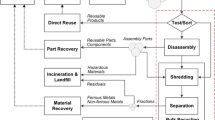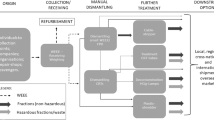Abstract
Recycling of waste electrical and electronic equipment (WEEE) is crucially important since it handles hazardous waste according to ever tightening laws and regulations and it adds benefits to economy and sustainable environment. Disassembly is one of the most important processes performed during the recovery of WEEE. The overall goal of disassembly is to maximize the retrieval of various metals and plastics contained in WEEE in order to reduce their negative effects on human health and environmental sustainability and to increase economic gains. This study aims to evaluate alternative layout configurations for WEEE disassembly systems (WDS). In this context, various configurations were compared in terms of pre-defined performance criteria, such as the total number of disassembled WEEE and the total revenue from sales, using simulation models. The results of this study show that the performance of a WDS was significantly affected by output transfer systems along with the specialization of operators on certain types of WEEE.

Similar content being viewed by others
References
Dinler E, Güngör Z. Planning decisions for recycling products containing hazardous and explosive substances: A fuzzy multiobjective model. Resources, Conservation and Recycling, 2017, 117 (Part B): 93–101
EC. Directive 2000/53/EC of the European Parliament and of the Council of 18 September 2000 on end-of life vehicles. Official Journal of the European Communities, 2000, L 269: 34–42
EU. Directive 2002/95/EC of the European Parliament and of the Council of 27 January 2003 on the restriction of the use of certain hazardous substances in electrical and electronic equipment. Official Journal of the European Union, 2003, L 37: 19–23
EU. Directive 2011/65/EU of the European Parliament and of the Council of 8 June 2011 on the restriction of the use of certain hazardous substances in electrical and electronic equipment (recast). Official Journal of the European Union 2011, L 174: 88–110
EU. Directive 2012/19/EU of the European Parliament and of the Council of 4 July 2012 on waste electrical and electronic equipment (WEEE) (recast). Official Journal of the European Union, 2012, L 197: 38–71
EU. Directive 2002/96/EC of the European Parliament and of the Council of 27 January 2003 on waste electrical and electronic equipment (WEEE). Official Journal of the European Union, 2003, L 37: 24–38
Kang H Y, Schoenung J M. Electronic waste recycling: A review of U.S. infrastructure and technology options. Resources, Conservation and Recycling, 2005, 45(4): 368–400
Williams J A S. A review of electronics demanufacturing processes. Resources, Conservation and Recycling, 2006, 47(3): 195–208
Ilgin M A, Gupta S M. Environmentally conscious manufacturing and product recovery (ECMPRO): A review of the state of the art. Journal of Environmental Management, 2010, 91(3): 563–591
Gungor A, Gupta S M. Issues in environmentally conscious manufacturing and product recovery: A survey. Computers & Industrial Engineering, 1999, 36(4): 811–853
Gungor A, Gupta S M. An evaluation methodology for disassembly processes. Computers & Industrial Engineering, 1997, 33(1–2): 329–332
Gungor A, Gupta S M. A solution approach to the disassembly line balancing problem in the presence of task failures. International Journal of Production Research, 2001, 39(7): 1427–1467
Altekin F T, Kandiller L, Ozdemirel N E. Profit-oriented disassembly-line balancing. International Journal of Production Research, 2008, 46(10): 2675–2693
Güngör A, Gupta S M. Disassembly line in product recovery. International Journal of Production Research, 2002, 40(11): 2569–2589
Ilgin M A, Gupta S M, Battaïa O. Use of MCDM techniques in environmentally conscious manufacturing and product recovery: State of the art. Journal of Manufacturing Systems, 2015, 37(Part 3): 746–758
Pérez-Belis V, Bovea M D, Ibáñez-Forés V. An in-depth literature review of the waste electrical and electronic equipment context: Trends and evolution. Waste Management & Research, 2015, 33(1): 3–29
UNEP. Call for Global Action on E-waste. Nairobi: United Nations Environment Programme, 2006
UNEP. E-waste 2.0: Recycling for Sustainability. Nairobi: United Nations Environment Programme, 2016
Seliger G, Kernbaum S. Planning for remanufacturing and recycling. In: Seliger G, ed. Sustainability in Manufacturing: Recovery of Resources in Product and Material Cycles. Berlin: Springer, 2007, 313–341
Opalić M, Kljajin M, Vučković K. Disassembly layout in WEEE recycling process. Strojarstvo. Journal for Theory and Application in Mechanical Engineering, 2010, 52(1): 51–58
Lim H H, Noble J S. The impact of facility layout on overall remanufacturing system performance. International Journal of Industrial and Systems Engineering, 2006, 1(3): 357–371
Ma H, Tang Y, Li L, Li C. An optimal solution to the remanufacturing facility layout problem. In: Proceedings of 11th World Congress on Intelligent Control and Automation. Shenyang, China: IEEE, 2014, 1729–1734
Noble J S, Lim H H. Evaluation of facility layout alternatives for a remanufacturing environment. In: Proceedings of Environmentally Conscious Manufacturing II, 2002. Boston, MA: SPIE, 2002, 158–166
Scharke H. Comprehensive Information Chain for Automated Disassembly of Obsolete Technical Appliances. 1st ed. Berlin: GITO Verlag, 2003
Opalić M, Vučković K, Panić N. Consumer electronics disassembly line layout. Polimeri, 2004, 25(1–2): 20–22
Limaye K, Caudill R J. System simulation and modeling of electronics demanufacturing facilities. In: Proceedings of International Symposium on Electronics and the Environment, 1999. Danvers, MA: IEEE, 1999, 238–243
Hesselbach J, Westernhagen K V. Disassembly simulation for an effective recycling of electrical scrap. In: Proceedings of First International Symposium on Environmentally Conscious Design and Inverse Manufacturing, 1999. Tokyo: IEEE, 1999, 582–585
Ranky P G, Morales L C, Caudill R J. Lean disassembly line layout, and network simulation models. In: Proceedings of International Symposium on Electronics and the Environment, 2003. Boston, MA: IEEE, 2003, 36–41
Herrmann C, Luger T, Ohlendorf M. SiDDatAS-Analysis and economic evaluation of alternative disassembly system configurations. In: Proceedings of Fourth International Symposium on Environmentally Conscious Design and Inverse Manufacturing, 2005. Tokyo: IEEE, 2005, 210–215
Sim E, Kim H, Park C, Park J. Performance analysis of alternative designs for a vehicle disassembly system using simulation modeling. In: Baik D K, ed. Systems Modeling and Simulation: Theory and Applications. Berlin, Heidelberg: Springer Berlin Heidelberg, 2005, 59–67
Wiendahl H P, Scholz-Reiter B, Bürkner S, Scharke H. Flexible disassembly systems-layouts and modules for processing obsolete products. Proceedings of the Institution of Mechanical Engineers. Part B, Journal of Engineering Manufacture, 2001, 215(5): 723–732
Drira A, Pierreval H, Hajri-Gabouj S. Facility layout problems: A survey. Annual Reviews in Control, 2007, 31(2): 255–267
Capraz O, Polat O, Gungor A. Planning of waste electrical and electronic equipment (WEEE) recycling facilities: MILP modelling and case study investigation. Flexible Services and Manufacturing Journal, 2015, 27(4): 479–508
Chung C A. Simulation Modeling Handbook: A Practical Approach. Boca Raton, FL: CRC Press, 2003
Wright T P. Factors affecting the cost of airplanes. Journal of the Aeronautical Sciences, 1936, 3(4): 122–128
Acknowledgements
This research was partially funded by The Scientific and Technological Research Council of Turkey (TÜBİTAK) under the grant number 111M428.
Author information
Authors and Affiliations
Corresponding author
Rights and permissions
About this article
Cite this article
Capraz, O., Polat, O. & Gungor, A. Performance evaluation of waste electrical and electronic equipment disassembly layout configurations using simulation. Front. Environ. Sci. Eng. 11, 5 (2017). https://doi.org/10.1007/s11783-017-0992-9
Received:
Revised:
Accepted:
Published:
DOI: https://doi.org/10.1007/s11783-017-0992-9




